You are interested in buying a String of Turtles plant or are looking to care for your Peperomia prostrata in the best way possible. In this care guide from A to Z. I list all you need to know, from soil to water to how to propagate.
Takeaways
| Species | Peperomia prostrata |
| Synonyms | String of Turtles,Turtleback Plant |
| Family | Piperaceae |
| Genus | Peperomia |
| Growth | Climbing, trailing |
| Height | 0.8 feet |
| Width | 1.7 feet |
| Soil | Well-draining soil. Peat moss, vermiculite, and perlite. |
| Watering | Every 10-14 days |
| Light | Bright indirect |
| Temperature | 64°F to 75°F (18°C - 24°C) |
| Humidity | 40-60% |
| Fertilizer | Twice a week |
| Propagation | Stem cuttings |
| Toxicity | Toxic to cats and dogs as well as humans |
What is a String of Turtles Plant?
String of Turtles or Peperomia prostrata is an easy-to-care-for indoor plant. Peperomia prostrata is native to Brazil.
It is spelled pep-er-ROH-mee-uh prost-RA-tuh, according to the NC State University. Other “string of” plants are String of pearls and String of hearts.
This compact radiator plant is an excellent choice for hanging baskets, containers, and greenhouses.
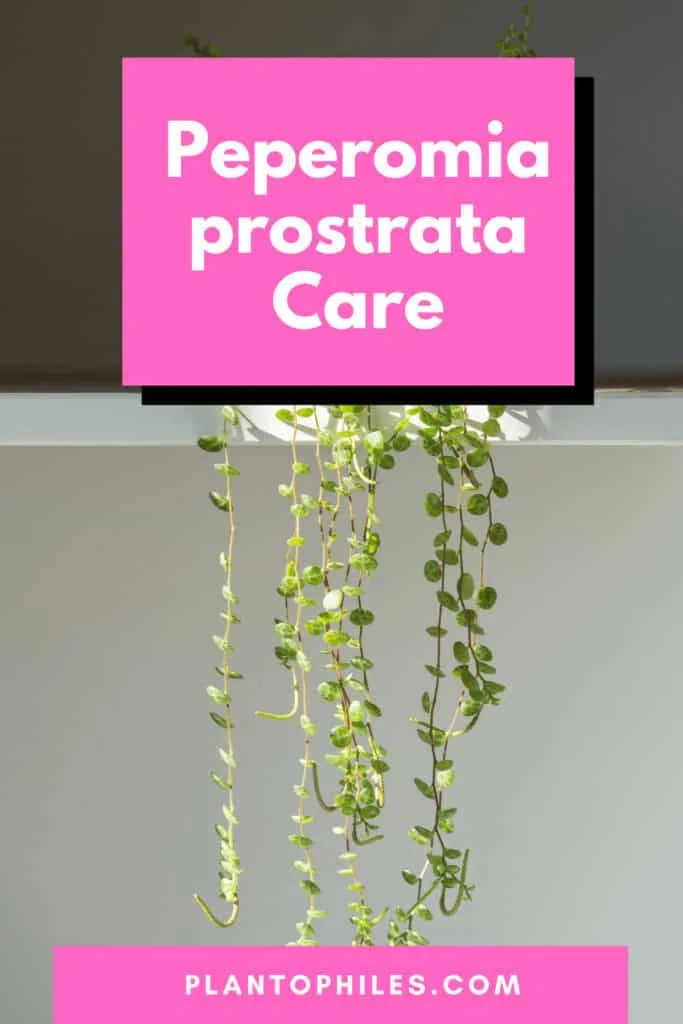
Table of Contents
String of Turtles Care
To care for the String of Turtles, provide a peat-based soil that is airy and well-draining. It prefers bright, indirect sunlight. Water every two weeks and add 1/5th of the volume of the pot. Keep the soil slightly humid in spring and summer. The ideal temperature lies between 64°F to 75°F (18°C – 24°C). Provide a humidity of around 50%. Fertilize once every two weeks with diluted liquid fertilizer at half-strength in spring and summer. Fertilize once a month in winter.
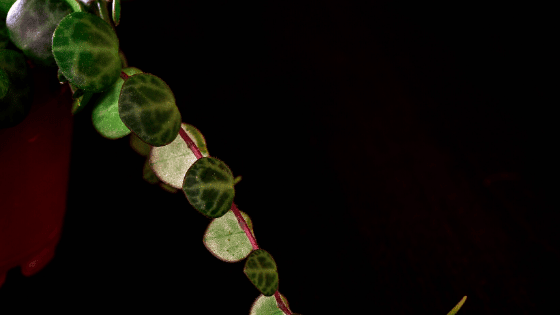
It is a slow-growing tropical annual and perennial with succulent leaves. The String of Turtles prefers cold to warm temperatures with humid weather, in other words, average home temperature.
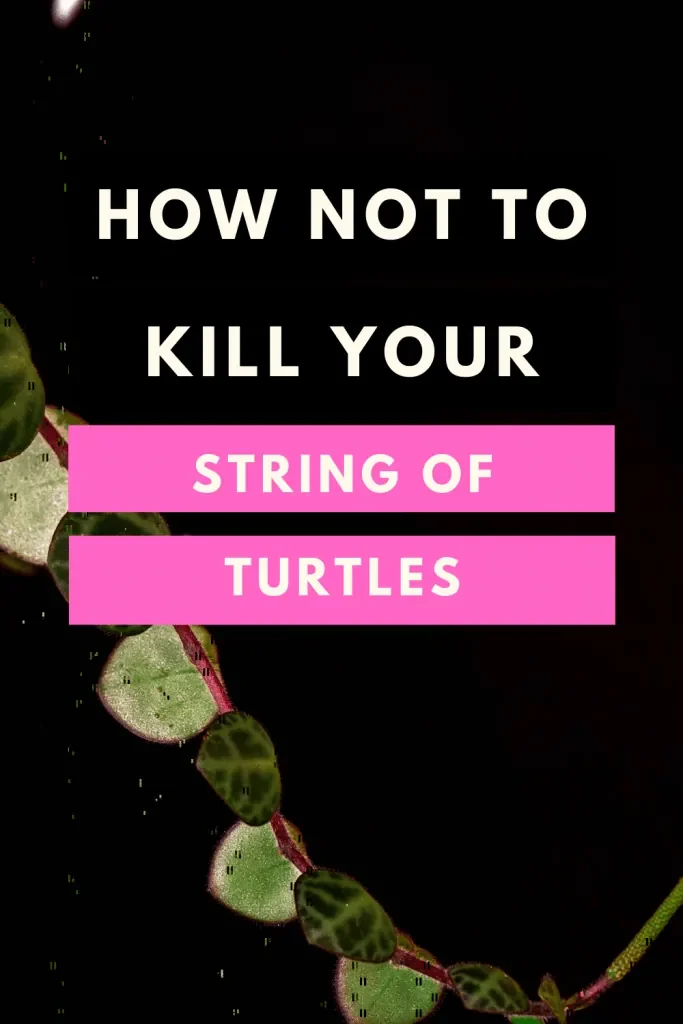
Table of Contents
String of Turtles Care Guide
Peperomia prostrata is a well-behaved and beautiful-looking vining plant. Follow the care tips given below to grow a healthy peperomia prostrata.
Soil
String of Turtles prefers peat-based soil that is well-drainingand has excellent aeration properties.
Originating from South American rainforests, String of Turtles enjoy loamy and wet soil conditions.
But be wary that this plant cannot tolerate waterlogged soils; the fragile stems will rot if the plant is kept soggy for an extended period.
It is crucial to maintain proper drainage to get rid of the excess water for plant growth.
You can improve the aeration of the soil by adding perlite to the potting mix.
Fertile potting soil will encourage root growth and increase the vine’s strength.
Choose a soil with a pH of 5 to 7 that is acidic to neutral.
Light
The String of Turtles is a sun-loving succulent that enjoys bright but indirect light for optimum growth.
Do not expose this Peperomia plant to direct sunlight for several hours. One or two hours of direct sun during the morning is more than enough. Otherwise, the foliage can scorch.
This indoor plant can also be easily grown under artificial or fluorescent lights.
Choose a north-facing or south-facing window sill to place the pot for optimal light conditions.
You can read more about the best window directions for specific plant requirements in my blog post about light levels for plants.
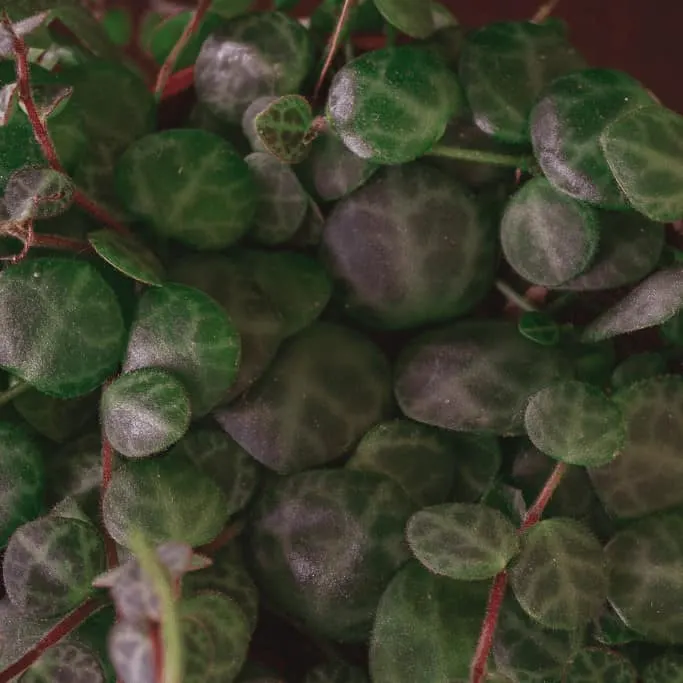
Watering
Water String of Turtles every 10-14 days.
In terms of watering, it’s better to underwater than overwater String of Turtles as they can rot easily.
This succulent plant prefers slightly moist soil conditions.
Therefore, I suggest keeping the soil moist in the growing season, but in summer and winter, allow the soil to dry properly before watering.
Do not make the soil waterlogged by overwatering.
Check the plant before irrigation; water the plant when the top few inches of the soil are dry.
In the case of overwatering the plant will start shedding leaves.
But if too many leaves have begun falling, temperature and fertilizer might be the culprit.
The Peperomia prostrata plant is highly susceptible to overwatering.
Wilted scab-like bumps on the leaves indicates overwatering.
When the roots are waterlogged, the essential nutrients from the soil are washed away that will cause the leaves to shed.
In winter, water sparingly since the leaves will store water.
With less temperature and light, the plant needs less watering.
To avoid overwatering, give the plant water equal to 1/5th of the volume of the pot. Water the plant once every two to three weeks.
You can typically water the plant using the top watering method. But if you have a small pot, you can also consider bottom watering.
For bottom watering, place the pot in a container and fill it water so that 1/4th of the pot is submerged in water.
Leave the pot in the container for about 10 minutes and later allow the water to drain.
Your plant can also suffer from under-watering with deflated or flat leaves, little or no growth, and a significant decrease in foliage.
If the pot is placed in a spot with too much sunlight, the soil will dry out too quickly and scorch the plant’s leaves. This is when you must move your plant to a shady location to avoid the worst.
Be careful while watering. Do not allow the excess moisture to sit on the soil surface. You can use the bottom-up method to avoid root rot.
Root rot is a severe condition that can kill your plant. Read more about root rot in this blog post.
Temperature
Maintain a temperature between 64°F to 75°F (18°C – 24°C) but never lower than 50°F (10°C) for the String of Turtles.
Peperomia prostrata is not frost-hardy; the vines will wilt in temperatures lower than 50°F (10°C).
This plant will be happy in general room temperature conditions
Humidity
Compared to other succulents, Peperomia prostrata prefers slightly more humidity and water.
50% humidity is sufficient for the String of Turtles plant.
In summer, mist the leaves or place the plant in a gravel tray with water to increase the humidity.
But make sure that the leaves do not stay wet for too long.
Pruning
The main goal of pruning is to control size and growth. If your vine has grown excessively bushy, prune the top of some of the stems to reduce the growth.
You can also remove the bigger stems, dead foliage, or damaged leaves.
Avoid heavy pruning as it will cause the plant to lose its lush, bushy appearance, and significantly hinders plant growth.
Pruning is necessary to keep this spreading plant under control.
If you notice the stems or leaves are overgrowing, you can pinch the stems to stop growth.
With overgrowing leaves and stems, the plant looks less pleasing and out of shape in appearance.
Use a sterilized knife or scissors for pruning to avoid infection or disease.
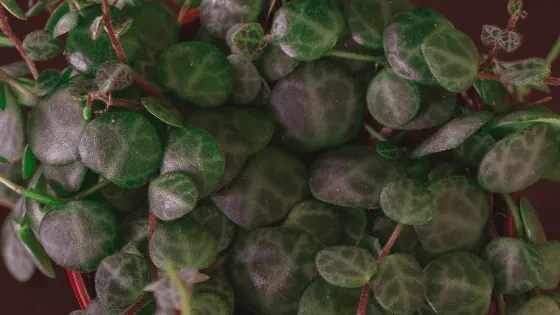
Fertilizer
Fertilize String of Turtles with a diluted liquid fertilizer every two weeks in the growing season.
Alternatively, you can use time-release fertilizer pellets at the start of the growing season.
The regular application of fertilizer retains the color and pattern of the leaves.
In summer, reduce the fertilizer application; apply only once a month. Don’t feed the plant from fall to late winter seasons.
You can also apply the fertilizer by mixing it with water.
But remember, a small quantity goes a long way. Too much fertilizer in the soil or water, the leaves will start dropping.
Generally, you should apply half-strength general plant fertilizer or houseplant feed once a month all year round.
If you are using ‘ready to pour’ fertilizers, always water the soil before application to avoid root-burning.
String of Turtles Propagation
The best time to plant a Peperomia prostrata is around March. You can easily propagate the prostrata plant with leaf cuttings, root, or stem cuttings.
Step by step Peperomia prostrata propagation guide:
- Choose the healthiest stems for propagation, i.e., it should not be very dry or damaged.
- Cut at least 5 inches of the vine.
- Coil the vine in a circular shape and place it in a pot with fresh, moist, and well-drained potting mix.
- Do not cover the vine and leaves with soil; it will harm the light-capturing efficiency.
- Don’t water the newly potted plant until a week has passed.
- Now place it in a propagation case; mist the soil and foliage once every week for humidity.
- Do not seal the top of the case, as excessive humidity is harmful to this semi-succulent plant.
- Provide sufficient watering but do not overwater the plant.
- Keep the pot under bright, indirect light with a temperature higher than 18 degrees Celsius.
- Check the vine every few days for any yellow or rotten leaves and remove them.
- When the foliar develops, treat the plant according to the care guidelines of Peperomia prostrata.
You can also place the lower half of the vine in water until roots appear.
Replace the water every few days and remove damaged leaves.
In this case, the root development can take up to 2 months.
If you are using tip cuttings, remove the lowest pair of leaves and dip the stem in rooting hormone for faster growth.
You can also propagate with leaf cuttings, but you may lose the variegation with this method.
Lay the cuttings on a surface for two hours or so to allow a protective callus tissue to form on the cuts.
You can place the cutting directly in soil or put it in a glass of water.
When roots are established, transfer the cuttings to 3-inch pots or hanging baskets.
Growth
The Peperomia prostrata plant itself does not grow very large; all the growth is focused on the vines.
Prostrata is a miniature plant with a plant height of 1 foot, and the plant width varies based on the pot size. The max. height will be achieved in 3-5 years.
Without pruning or trimming, they can grow even larger in length.
The small leaves have beautiful patterns of white veins that vary in color from maroon to dark blue to purple for young plants and become silvery-white as the plant matures.
Occasionally inspect your plants for dead or infected leaves and trim them. Do not trim the plant too much; it will shock the plant and affect the growth.
Potting
Use a container with drainage holes and choose a loose, well-aerated, well-drained potting mix for growing Peperomia prostrata.
Prepare the potting mix by mixing two parts peat and 1 part perlite or sand. Peperomia is a small plant; it does not require repotting to larger containers.
The plant grows relatively slow, especially during the early growth period.
Do not over pot the plant as it will cause waterlogging.
Add fresh soil to the top layer of the pot once a year.
I recommend refreshing the soil in the spring season; change the soil or at least the topsoil, but after root pruning, place the plant in the same size pot or only one size bigger pot.
This plant has a small root system; therefore, shallow containers are preferred. Only repot the plant if it’s getting too crowded.
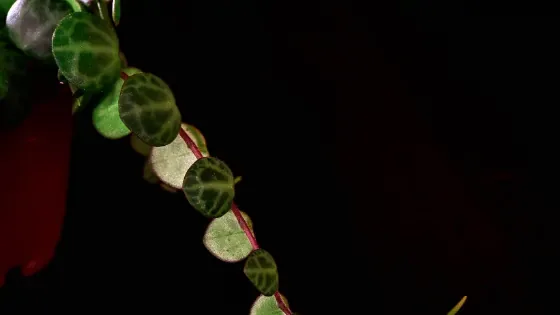
String of Turtles Flower
The String of Turtles flower is cream-colored with no scent. The flowers look like little spikes.
You can leave or cut the flowers, depending on the look you aim for. You can also cut off the flowers to encourage growth. Peperomia prostrata does not flower often indoors.
Is the String of Turtles toxic?
String of Turtles is toxic to pets such as cats and dogs. If swallowed, it can cause irritation, vomiting, or diarrhea. I recommend always keeping this plant out of reach of your pets.
Common Problems for Peperomia prostrata
Peperomia prostrata is a stress-free plant but it is vulnerable to some of the common houseplant diseases and pests:
Root rot
Rot can also initiate from the soil and make its way up towards the peperomia plant. If the plant is left untreated, root rot will stunt the growth, the leaves will turn yellow, and the vines will eventually die.
Immediately dry out the soil from around the Peperomia prostrata. Take your plant out of the pot and inspect the roots.
Mushy roots with soggy soil indicate an unhealthy root system.
Transfer the Peperomia prostrata plant to a new pot with new, fresh soil, and make sure you don’t water the plant for the next two weeks to allow it to heal from the root rot.
Mealybugs
Prostrata is susceptible to mealybugs, that is present as fuzzy white stuff on the stems or bottom of the leaves.
These bugs can easily spread and infect other indoor plants. These small bugs eat the new growth on the plant. Overwatering and over-fertilizing is the most common cause of mealy bugs.
To treat mealy bugs, prepare a solution of isopropyl alcohol and water with a ratio of 1:10. Thoroughly spray this solution on the leaves.
Another prudent step is to move the infected plant away from other healthy plants. Continue this spray until you get rid of the bugs completely.
Spider mites
Spider mites are destructive pests for houseplants; they create small webs on the plants. The webs are mostly located at the underside of the leaves or the leaf joint.
These are white, red, or black colored spiders, and they make the plant leaves look dusty and white. They are a significant problem in winter months since most indoor conditions are dry.
This pest multiplies very rapidly, and the population increases. The spider mites suck the sap from the leaves of the peperomia prostrata making the vines look discolored, dried, or curled.
If left untreated, spider mites can eventually kill the plant. To kill the mites, wash the plant with homemade insecticidal soap.
Keep the humidity levels high to avoid spider mite infections in the future and use neem oil as a preventive spray.
Whiteflies
Whiteflies are tiny white flying bugs that are one of the most common pests for houseplants. When you disturb or move the leaves of the plant, the adult flies will fly around if the plant is infested.
The female flies lay eggs on the underside of the plant leaves, so flip the leaves and inspect them for any eggs or whiteflies.
They suck the juices from the leaves and flower buds, which will cause yellowing and dropping of leaves.
Small indoor plants such as peperomia prostrata are highly vulnerable to whiteflies’ damage.
You can use organic insecticidal soap to kill the eggs and nymph and eventually spray neem oil to prevent the whiteflies from coming back.
You can check out our article about whiteflies to get a better understanding of how to get rid of them.
Wilted or discolored leaves due to overwatering: You can solve this problem by draining the excess water from the pot. While watering the plant, take care that you should not soak the leaves else; they will rot.
Dull, damaged leaves
If the plant is placed under strong direct sunlight, the plant may appear dull and lifeless.
And the leaves will lose their multicolored variation.
This issue can be resolved by relocating the plant and moving it away from the harsh sunlight.
Where to buy String of Turtles
Buy Peperomia Prostrata directly at Amazon and save yourself some money!
FAQ
How often should I water my String of Turtles?
Water the plant once every week or two for a few minutes. But always allow the plant and soil to dry properly before the next watering session. Bottom-up watering is the most suitable for the Peperomia prostrata plant against root and foliage rot.
Why do String of Turtles turn yellow?
Yellow leaves for this plant are one of the most common indicators of overwatering. The String of Turtles must go through periods of dry soil between watering. If you are not allowing the plant to drain properly and the water sits on top of the soil, this might cause the vine to turn yellow or rot. You can regain the green foliage by improving watering care for the plant.
How can I increase humidity in winter for my String of Turtles?
In winter, heating will reduce the indoor humidity levels. You can mist the plant leaves with soft water to increase humidity. In winter, you should water the plant light only when the soil is dry.
Can a String of Turtles grow in low light?
The String of Turtles can tolerate low light. But it will not grow well and will not have healthy foliage.
The plant will survive, but the leaves will lose their coloration. Low light is not recommended for variegated species such as prostrata.
Can a String of Turtles grow outside?
String of Turtles can grow outside in USA hardiness zones from 10 to 12. But most gardeners prefer to grow them as evergreen houseplants.
Why are the leaves of the String of Turtles plant turning red?
Red foliage occurs when the leaves of String of Turtles are excessively exposed to direct sunlight. This plant can tolerate direct sunlight for only a few hours when the sun is not too intense. You can limit sun exposure to only 1 hour per day to solve this problem. Remove all the damaged, red, or yellow leaves to help the plant focus on new growth.
Conclusion
The String of Turtles makes a perfect houseplant as it can tolerate many conditions. I
t is straightforward to care for Peperomia prostrata, and the average conditions in your home are perfect.
Just provide this indoor plant with medium to full sunlight and occasional watering and keep it in check with occasional pruning of the plant back.
This compact radiator plant will be an excellent indoor houseplant jungle addition.

Daniel has been a plant enthusiast for over 20 years. He owns hundreds of houseplants and prepares for the chili growing seasons yearly with great anticipation. His favorite plants are plant species in the Araceae family, such as Monstera, Philodendron, and Anthurium. He also loves gardening and is growing hot peppers, tomatoes, and many more vegetables.


